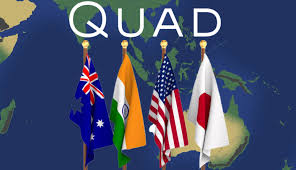
1. Complex Interdependence: Economic ties with China, particularly trade imbalances, heavily influence the QUAD’s cautious approach, limiting bold actions against China’s rise.
2. Maritime Security Initiatives: The QUAD’s 2024 Leaders’ Summit emphasized maritime security with new initiatives like the MAITRI workshop and joint coast guard exercises.
3. Non-Military Alliance: Despite US-China rivalry, the QUAD remains a partnership, not a formal military alliance, driven by strategic cooperation rather than direct confrontation.
The Quadrilateral Security Dialogue (QUAD) continues to stir discussions about its relevance in global security frameworks. The 2024 Leaders’ Summit, held on September 21, maintained the familiar rhetoric on maritime security while introducing several new initiatives. However, to fully grasp the dynamics of the QUAD, it’s important to look beyond surface-level discussions. This article delves into the outcomes of the summit and examines the more intricate factors that will influence the future direction of the group.
On September 21, 2024, the QUAD conducted its sixth summit-level meeting in Delaware, hosted by the United States. The summit was attended by key leaders, including Indian Prime Minister Narendra Modi, U.S. President Joe Biden, Japanese Prime Minister Fumio Kishida, and Australian Prime Minister Anthony Albanese. Although the event’s importance was clear, considering the collective power of the four nations, the effectiveness and relevance of the summit’s outcomes are still debated. As I noted in my previous article, the key question was whether the summit would move beyond rhetoric on maritime security and begin implementing actionable strategies, and how this would impact the QUAD in the coming years.
Brief Assessment of the QUAD’s Maritime Security Stance

As with previous summits, the Leaders’ Summit resulted in both rhetoric and the launch of a few new initiatives. The joint statement expressed concerns over the situation in the East and South China Seas, condemning the militarization of disputed features and reiterating adherence to international law to establish a maritime rules-based order. Despite Indian PM Modi’s statement, “We are not against anybody,” the grouping’s condemnation of the use of coast guard and maritime militias and their opposition to the disruption of offshore resource exploitation by other countries undoubtedly points to recent Chinese activities vis-à-vis the Philippines. The members upheld the 2016 Arbitral Award on the South China Sea, which favored the Philippines regarding the Chinese coast guard’s presence on the Sabina Shoal, located 150 km off its west coast. Although the international tribunal in The Hague had not declared sovereignty to either party, the QUAD emphasized the need to respect territorial integrity.
Thus, it can be observed that the grouping’s interest in addressing the concerns of the Philippines is increasing, suggesting an attempt to include countries with converging interests. However, the most significant takeaway concerning maritime security rhetoric could be the one stated in the India-US bilateral meeting ahead of the QUAD summit, emphasizing that the QUAD continues to be defined as a partnership, not a military alliance.
At the summit, US President Biden stated: “We are democracies. We are democracies who know how to get things done… We elevate the Quad, making it more consequential… And today, we have announced initiatives that deliver real positive impact for the Indo-Pacific…” Backing these words, the QUAD launched the MAITRI initiative (Maritime Initiative for Training in the Indo-Pacific) to train the QUAD partners to monitor the waters. India will host the first MAITRI workshop in 2025. The members also decided to conduct joint coast guard exercises. Further, as predicted, the summit provided new technological impetus to the existing Indo-Pacific Partnership for Maritime Domain Awareness and Maritime Training (IPMDA) initiative. These were the key outcomes of the summit regarding maritime security.
However, now that the Leaders’ Summit has concluded, broader questions arise beyond the rhetoric and newly launched initiatives. What future is the QUAD headed toward? What are the driving forces that will determine its trajectory? These are the more important questions whose answers can only be found through a deeper theoretical analysis.
Beyond the Leaders’ Summit: Theoretical Analysis of the QUAD’s Rationale

From a theoretical perspective, various influences shape the behavior and foreign policy of the QUAD. The primary determinant is the concept of the Thucydides Trap: the inevitability of a clash between a hegemon and a rising challenger power, best expressed in the 21st century through the US-China rivalry. Therefore, as foreign policy is a state’s endeavor to change another state’s behavior according to its needs, the US’s foreign policy to counter China’s rise is the primary source of influence behind the QUAD. Meanwhile, when great powers clash, other powers also suffer from a security dilemma that pushes them to attain a balance of threat by forming alliances with either side. This theoretical paradigm might explain the source of influence behind the membership of Australia, Japan, and India in the QUAD.
However, if this explanation were the sole driving force behind the QUAD, the grouping would have long metamorphosed into a military alliance and taken the shape of an “Asian NATO,” as some seem to call it. Unfortunately, for novices of the subject, international relations are far more nuanced, as proven by the constant reiteration by the QUAD that it is only a partnership and not a formal alliance. While this irony may appear to most as a contradiction between theory and practice, the explanation is incomplete without considering another central feature of international relations: the concept of complex interdependence.
Interdependence is central to explaining the nature and dynamics of international relations (Coate, Griffin, Elliott-Gower, 2017). Thus, when critics wonder why the QUAD hesitates to take more direct actions, this paradoxical concept might explain how the four members benefit from countering the rise of China while some of their interests also depend on China’s rise, thereby forcing the grouping to tread more cautiously and rely more on rhetoric than on direct action.
How Is Complex Interdependence Influencing the QUAD?
A closer look is required to understand the complex dynamics between the QUAD members and China. As the primary interest of QUAD countries is to maintain their respective spheres of strategic influence in their regions, they benefit by deterring the rise of China in the Indo-Pacific. However, in a world interlinked by business, economics is one of the biggest determinants of foreign policy. At present, this economic upper hand lies in the hands of China through its trade imbalance with the four members.
Since 2009, China has consistently been the largest import partner of the USA, overtaken only by Mexico in 2022. Moreover, in 2023, the USA’s trade deficit with China rose to $279.4 billion. Similarly, Japan also has a trade deficit with China, valued at 6 trillion Japanese yen as of 2023. In India’s case, in 2023-24, the trade deficit with China crossed the USD 100 billion mark for the first time, as China edged past the US to become India’s largest trading partner. However, the tide has turned in favor of Australia in recent years, resulting in a trade surplus of USD 81.8 billion in 2023, driven by its mineral exports to China. Nevertheless, the two countries have been in a trade war ever since, which is more likely to turn out in favor of China due to the People’s Bank of China’s willingness to easily devalue the yuan.
Thus, in a world of deep interlinkages between economic and strategic interests, complex interdependence would tie the hands of the QUAD as the purse strings of each country lie in China’s hands. This could be the underlying reason for the grouping’s overall hesitation in taking bolder decisions, at least as far as India is concerned. As China’s economy further recovers and its rivalry with the USA deepens, its assertiveness is likely to only grow further. To navigate that threat, so far, the QUAD members have been relying on negotiations and rhetoric, as US President Joe Biden pointed out that “intense competition requires intense diplomacy.” However, diplomacy can only go so far.

As Hans Morgenthau describes, international politics is a struggle for power. Throughout history, military power has been paramount, and economic power a luxury (James Graham, 2012). However, in the 21st century, power cannot be seen solely through its traditional lens of hard power. In the contemporary world, where the expression “Money is Power” is common sense, economic interdependence influences states’ decisions.
Therefore, if Indian Prime Minister Narendra Modi’s affirmation that “The QUAD is here to stay” is to truly be consequential in deterring China’s rise, then member countries need to keep in mind that “economic sources of power, which are easier to apply gradually and increasingly than threats of force… are often the handiest means of dealing with other states’ policies that impose significant costs on one’s own state” (Keohane and Nye Jr, 1973). Thus, for a long-term solution, the best course of action for the four QUAD members could be to tip the scale of the trade imbalance in their favor and gain the economic upper hand. If not, the complex interdependence between them and China will continue to hinder future QUAD deliberations.
About the author:
Bishwarupa Kar is a post-graduate student at the Department of Politics and International Studies, Pondicherry University. Her areas of interest include India and the Global South, Climate Change, Terrorism and Counterterrorism, Polar studies, and Theories of International Relations. Views expressed are author’s own.
Bishwarupa Kar is a post-graduate student at the Department of Politics and International Studies at Pondicherry University. Her areas of interest include Climate Change, Climate Action and Climate Financing, Global South, Terrorism, and Polar Studies. Views expressed are the author’s own.
